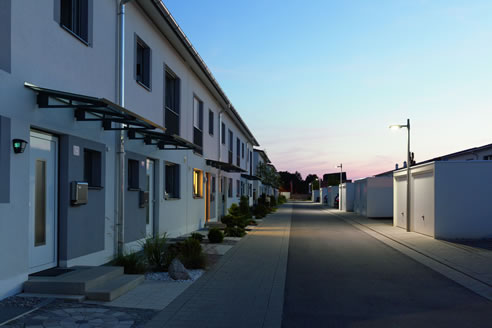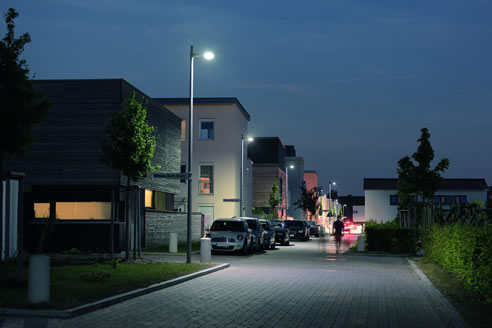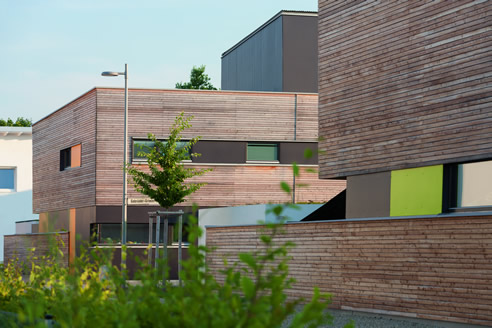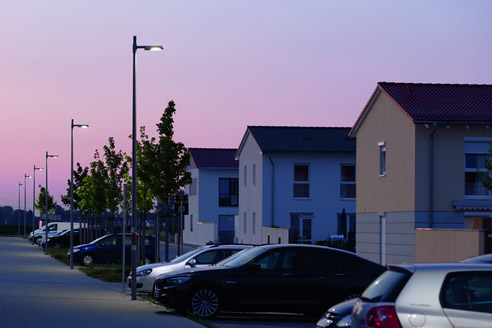Poing, in the district of Ebersberg, Bavaria, Germany, wants to be free of fossil
fuels and non-renewable energy sources by 2030. With this in mind, the local
authority employs a Climate Protection Officer and has initiated a number of
projects dedicated to the use of renewable energy sources and energy efficiency.
Poing also made a wise decision when choosing streetlighting for its new
residential neighbourhood, Zauberwinkel. Their selection of LED luminaires from
WE-EF ensures safety and superior illumination even at low-rated outputs.
Poing is a growing community. Since the start of the new millennium, it has
welcomed approximately 5,000 new residents. Situated just 20 kilometres from
Munich, the area is seen as a popular suburb, as proven by the construction of
several new residential neighbourhoods. The most recent of these is
Zauberwinkel. Detached and semi-detached houses as well as blocks of flats have
been built there on 20 hectares of land, providing homes for 1,400 people.
A well-developed local infrastructure, the availability of outdoor leisure activities
and the sense of being close to nature and yet still within easy reach of Munich
greatly contribute to the quality of life in Zauberwinkel. However, that's not all;
the neighbourhood's planners have also placed great emphasis on sustainability
and climate protection. Residential housing meets strict energy efficiency
standards, ranging from low-energy houses classed as KfW 70 (70 per cent of the
maximum value specified in the German Energy Conservation Ordinance) right
through to passive houses.

With a nominal wattage output of just 29 watts per luminaire, it has been possible to implement a system that ensures consistently low energy costs.
A geothermal system supplies the entire neighbourhood with thermal energy via a
remote heating network. In addition, all single-pitch roofs are pointed towards the
south in order to allow the use of solar energy systems. Energy efficiency and
product quality were also important criteria in the planning of the technical
specifications for the public areas of the neighbourhood. The local authority
therefore chose an LED-based solution for street lighting.
The six main thoroughfares and many residential streets in the neighbourhood are
illuminated with RFL530-SE LED street and area lighting luminaires from WE-EF.
With a nominal wattage output of just 29 watts or 59 watts per luminaire, it has
been possible to implement a system that ensures consistently low energy costs.
The long service life of the LEDs also makes the regular lamp replacement of
conventional lighting elements a thing of the past, providing tangible savings for
the community in terms of service and maintenance. The lighting planners were
impressed with the high performance and precision lighting features of the WE-EF
RFL530-SE LEDs, which includes the OLC® One LED Concept with multi-layer
technology and PMMA lenses. In this installation, the luminaires are fitted with
[S60] lenses, which generate a 'side throw' light distribution. They reliably meet
all standard specifications for the streets in Zauberwinkel in terms of uniformity
and glare reduction.
The luminaires were installed according to the needs of the overall community.
RFL530-SE LED luminaires have been installed on main thoroughfares at a
mounting height of six metres with a nominal wattage output of 59 watts. In
areas where residential streets adjoin neighbourhood squares and playgrounds -
including pedestrian pathways - the luminaire mounting height has been reduced
to five metres. The higher luminance not only addresses safety concerns, but also
emphasises the importance of public-use spaces. On residential streets, leading to
the main public spaces, the luminaires have a mounting height of four metres and
a nominal wattage output of 29 watts.

The lighting planners were impressed with the high performance and the precision lighting features of the WE-EF RFL530-SE LEDs, which include the OLC© One LED Concept with multi-layer technology and PMMA lenses.
WE-EF not only supplied the luminaires for this project, but also all cable
connection boxes, poles and extensions. As with the luminaires themselves, Poing
chose these components for their reliability, longevity and future-proof qualities.
A long service life is a clearly defined quality concept from WE-EF. This ranges
from the selection of the materials (marine-grade recycled aluminium for
luminaires) as well as material processing (five-level corrosion protection
system), to the use of weatherproof and durable connection and sealing
technology.
Intelligent electronics and an effective thermal management approach ensure
efficient LED operation. A thermal sensor permanently monitors the temperature
directly on the LED board. If a preset temperature is exceeded, the LED luminous
flux is dimmed to 50 per cent.
With their efficiency and long service life, the RFL530-SE LED luminaires meet the
essential requirements for the implementation of economical and ecological
streetlighting. However, WE-EF's commitment to environmental and resource
protection also goes one step further. As one of the first companies in the lighting
industry to use Environmental Product Declarations (EPDs), WE-EF documents in
detail the ecological footprint of its luminaires in line with ISO 14025 and
EN 15804 standards.

Residential housing meets strict energy efficiency standards, ranging from low-energy houses classed as KfW (70% of the maximum value specified in the German Energy Conservation Ordinance) right through to passive houses.
After more than one and a half years of intensive development and evaluation
work, EPDs are now available for 15 WE-EF street and area lighting luminaire
ranges. These product-specific data sheets provide verifiable, comparable
information about a product's environmental impact. They document the
environmental influence of a product, not just for the time it is operated, but over
the entire product life cycle, from the acquisition of raw materials to recycling.








 Modern Catenary Solution Fit for
Modern Catenary Solution Fit for WE-EF's New Managing Director for
WE-EF's New Managing Director for A New Era for WE-EF LIGHTING – A Home
A New Era for WE-EF LIGHTING – A Home Myers Park Lighting Upgrade:
Myers Park Lighting Upgrade: Bridging the Past and Future: Old Murray
Bridging the Past and Future: Old Murray WE-EF Profile Projectors for Sharper
WE-EF Profile Projectors for Sharper Award-winning Bay Pavilions, Arts +
Award-winning Bay Pavilions, Arts + Enhancing Transit Experience at Byron
Enhancing Transit Experience at Byron Intelligently Illuminating the Bay Run
Intelligently Illuminating the Bay Run WE-EF Lighting's Role in Protecting
WE-EF Lighting's Role in Protecting Sustainable LED Upgrade Kit from WE-EF
Sustainable LED Upgrade Kit from WE-EF A Natural Paradise Rottnest Island by
A Natural Paradise Rottnest Island by WE-EF LIGHTING's Braeside Expansion
WE-EF LIGHTING's Braeside Expansion Street and Area Pole-Mounted Luminaires
Street and Area Pole-Mounted Luminaires Smart Lighting Control Technology from
Smart Lighting Control Technology from High-Output Floodlights with Modern LED
High-Output Floodlights with Modern LED Bondi Beach Pavilion Reimagined by WE-EF
Bondi Beach Pavilion Reimagined by WE-EF Balancing Needs: Sea Turtle Conservation
Balancing Needs: Sea Turtle Conservation Architecturally Pleasing Recessed
Architecturally Pleasing Recessed Luminaires for Lake Macquarie Multi-Arts
Luminaires for Lake Macquarie Multi-Arts
